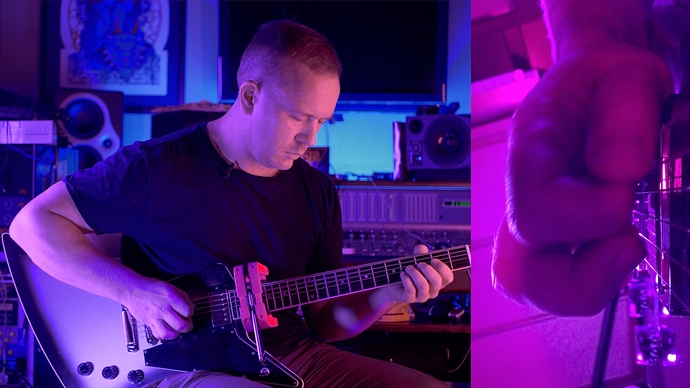Hi! Thanks for posting. And sorry for the confusion. In the Pickslanting Primer, we didn’t mean to imply you’re supposed to use wrist motion. We have sections in there on wrist-forearm and elbow motion too. And specifically, what you’re doing in this clip is textbook elbow motion in the style of Vinnie Moore and @Bill_hall, and it looks great. Here’s Bill:
You’ll notice the same radial wrist offset when Bill clicks into high gear. Vinnie More also does the same thing, as does John Taylor and lots of other great players. We did an interview with Bill last year which we’re woefully behind on editing, but the idea was specifically to shed more light on how using elbow as your core motion works.
In elbow land, with the form and motion you’re using, technically this usually results in a downstroke escape motion, where downstrokes are going up in the air. This works for any phrase where the downstroke is the final note on the string. And obviously not all phrases fit that. But great elbow players appear to use a variety of other tools, like little bits of wrist and forearm motion for specific moments in certain phrases, and also sometimes swiping, where you allow the pick to hit the unplayed string during a string change. Most of this is done subconsciously. They player is trying to be clean and get things to where they sound smooth and free of stray noise. If you get to that point, and it sounds good, then it is good.
In short I’m a fan of elbow technique and yours looks fine. Since it’s already working really well, I’d try and work on some phrases with it to expand your palette of what you can do with it. DSX type lines are a good starting point.
No problem in trying out other techniques while you’re at it. If you choose to go that route, I’d experiment by trying different grips and motions, and not wasting time on trying to apply the old-fashioned “drills and exercises” approach to anything that is slow and awkard. Instead, just try something else.
But again, since you have a motion which is already working this well, your best bang for the buck is going to be using it across a wide range of things.
Edit: Just as a request, if you can supply commentary in text form in your posts, that would be great. Much easier to scan, quote, and reply that way, and keeps the videos shorter, just a couple playing examples, 30 seconds tops, get in / get out. No big deal this time, and thanks for posting.



 Thanks for the tips!
Thanks for the tips!